-
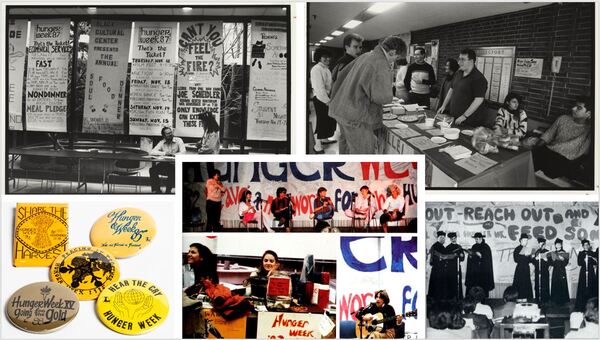
Black and white and color photographs of Hunger Week in the 1970s -1990s. Color photo of buttons from the 2002-2003 Hunger Week.
-
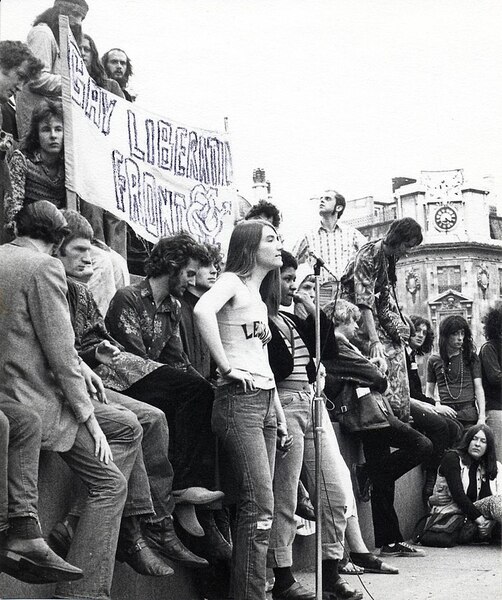
Gay rights demonstration (possibly in Trafalgar Square?) including members of the Gay Liberation Front (GLF.
The GLF held its first meeting in a basement classroom at the London School of Economics on 13th October 1970. It was inspired by the US GLF movements, which aimed to gain equal rights for the LGBT communities on an unapologetic basis. The organisation was very informal, having no designated structure, and organised marches, "gay days", street theatre performances, sit-ins and produced a journal entitled 'Come Together'. These activities led to the first Gay Pride March in 1972.
-
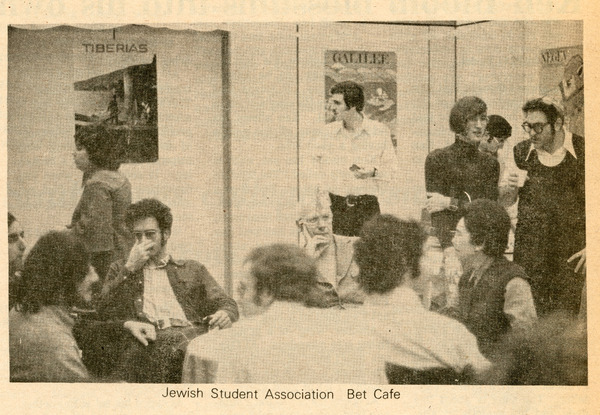
Photo from an article that appeared in the Loyola News on February 22, 1974 about the Jewish Student Organization.
-
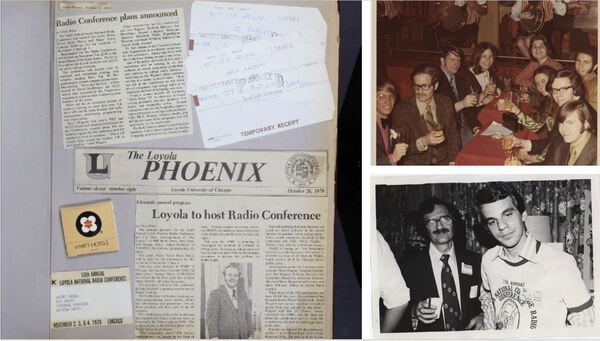
Collage includes: Scrapbook page, one color photo, and one black and white photo of radio conferences in the 1970s. Black-and-white photo includes Dr. Sammy Danna the founder of the conferences.
-
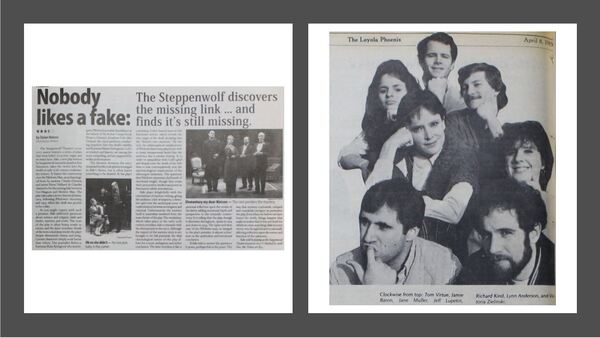
Two articles from the Loyola Phoenix. One is about the Practical Theatre Company and the other concerns the Steppenwolf Theatre
-
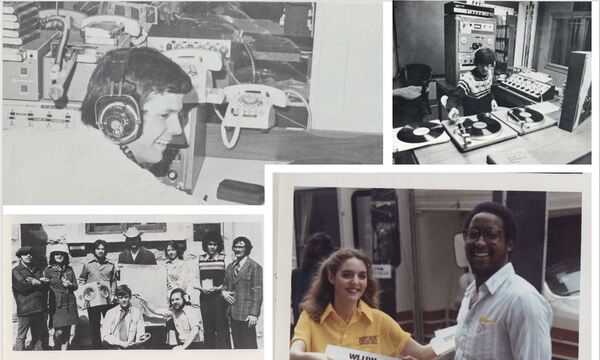
Four photographs of students and faculty involved with Loyola's radio station. Three are black-and-white and one color. Digital scans of physical photographs held by the UASC.
-
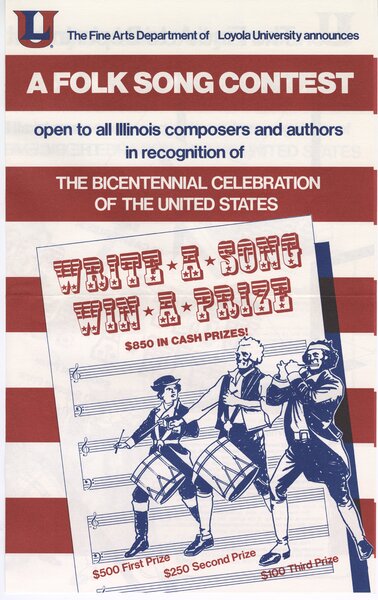
Large color poster advertising and giving instructions for the Bicentennial Folk Song Contest at Loyola
-
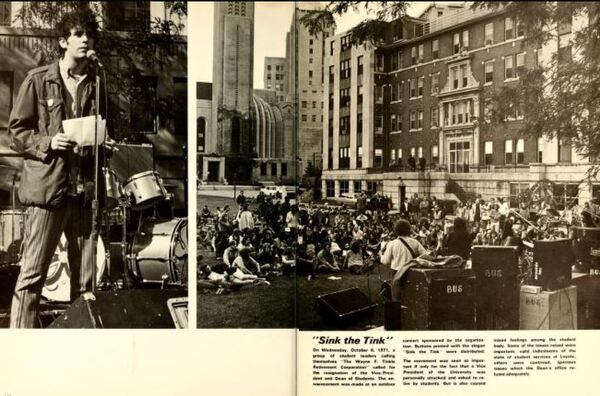
Yearbook entry on the "Sink the Tink" movement to force the Dean of Students Wayne F. Tinkle to resign. Two photos and text.
-

A collage of four photos taken at Loyola University Chicago during the protests following the shootings at Kent State in May of 1970.
-
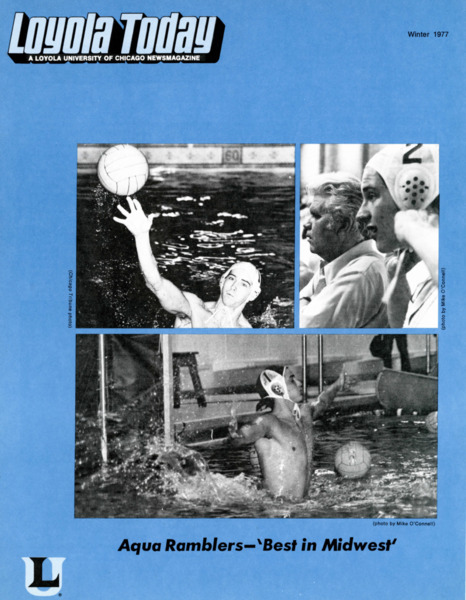
This blue cover of Loyola Today, a newsmagazine by Loyola University Chicago, features three images of the Aqua Ramblers, and their coach, Ralph Erickson. The caption is as follows:
"The Aqua Ramblers coached by Ralph Erickson placed seventh in the NCAA Water Polo Championship. Top left: Mike Martin; (Chicago Tribune photo) right: Coach Erickson and John Kussman; (photo by Mike O'Connell) below: goalie Jim Rennie (photo by Mike O'Connell)"
-
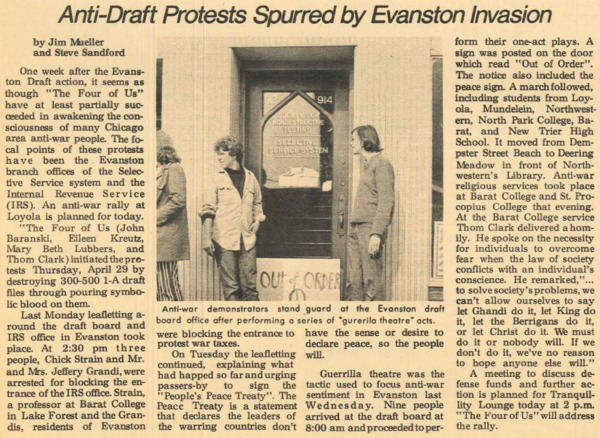
This article discusses the actions of "The Four of Us," four Loyola students who, on April 29, 1971, "invaded" the Evanston branch offices of the Selective Service system and the Internal Revenue Service. They destroyed 300-500 1-A draft files by pouring symbolic blood on them, then waiting for police to arrive and arrest them. The following Monday, three people, including local residents and professor Chick Strain of Barat College were arrested for blocking the IRS office entrance while leafletting and protesting war taxes. Leafletting continued on Tuesday, "explaining what had happened so far and urging passers-by to sign the 'People's Peace Treaty.'" The treaty "declares the leaders of the warring countries don't have the sense or desire to declare peace, so the people will." "Guerilla theatre was the tactic used to focus anti-war sentiment in Evanston last Wednesday, when "Nine people arrived at the draft board at 8:00 a.m. and proceeded to perform their one-act plays. A sign was posted on the door which read 'Out of Order.' The notice also included the peace sign. A march followed, including students from Loyola, Mundelein, Northwestern, North Park College, Barat, and New Trier High School. It moved from Dempster Street Beach to Deering Meadow in front of Northwestern's Library. Anti-war religious services took place at Barat College and St. Procopius College that evening. At the Barat College service Thom Clark [one of "The Four of Us"] delivered a homily. He spoke on the necessity for individuals to overcome fear when the law of society conflicts with an individual's conscience. He remarked '...to solve society's problems, we can't allow ourselves to say let Ghandhi do it, let King do it, let the Berrigans do it, or let Christ do it. We must do it or nobody will. If we don't do it, we've no reason to hope anyone else will.'
A meeting to discuss defense funds and further action is planned for the Tranquility Lounge today at 2 p.m. 'The Four of Us' will address the rally."
-
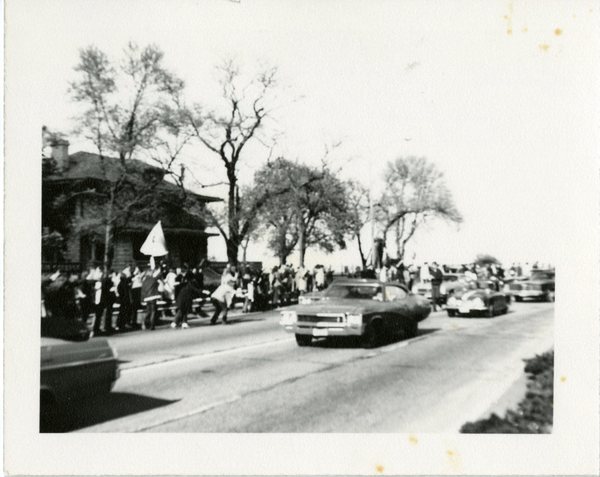
A large number of students line the north side of Sheridan Road on the Mundelein campus, in front of Piper Hall, during the May 1970 student strike. The strike was held in solidarity with the four students killed at Kent State University during an anti-Vietnam War protest on May 4, 1970.
Cars drive past, and many students gesture or hold signs aloft.
-
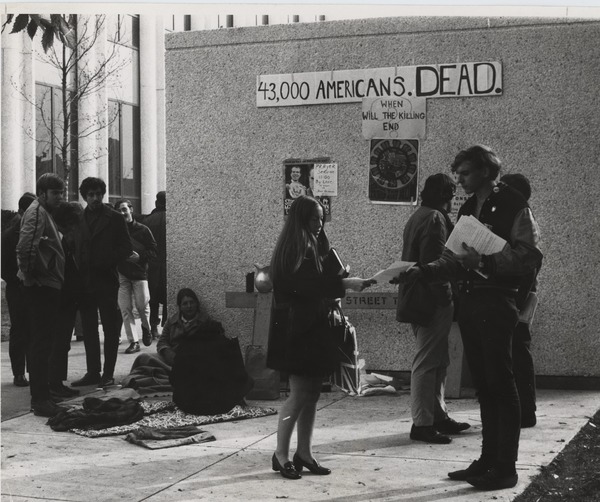
Outdoors, a student hands a piece of paper from a stack to another student. Several others look on, and two people sit on the ground. On the wall beside them, several signs are posted, reading "43,000 AMERICANS. DEAD." "WHEN WILL THE KILLING END?" "Prayer service 11:00 by Lake." Several other posters criticize Nixon and urge the removal of troops from Vietnam, but are not fully legible.
The Loyola strike was held in response to the killing of four students at Kent State University during an anti-Vietnam War protest on May 4, 1970. On May 5, students at Loyola voted to strike, beginning May 6.
-
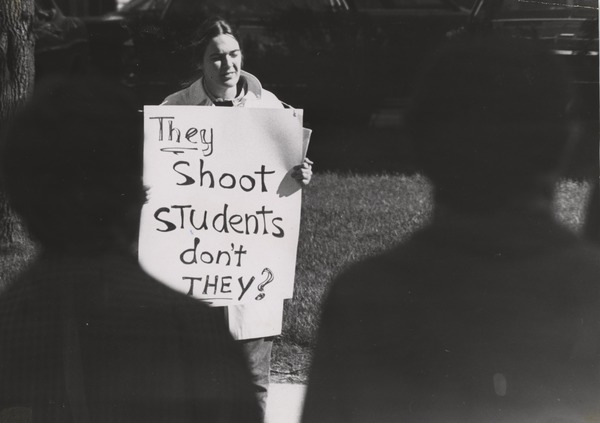
During the Loyola strike held the week of May 4, 1970, a student holds a large sign reading "They shoot students don't THEY?" Two figures stand in the foreground. The strike and demonstrations were held in response to the shocking killing of four students at Kent State University during an anti-Vietnam War protest on May 4. Thousand of Loyola and Mundelein students participated, along with faculty.
-
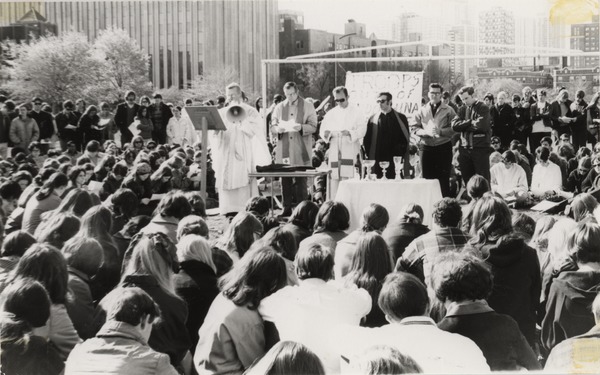
A large crowd of students and others gather outdooors, seated and standing, as clergy hold a mass to begin the Loyola strike on May 6, 1970 in response to the killing of four students in an anti-Vietnam War protest at Kent State, which occurred on May 4, 1970. On May 5, students decided to strike beginning the following morning.
-
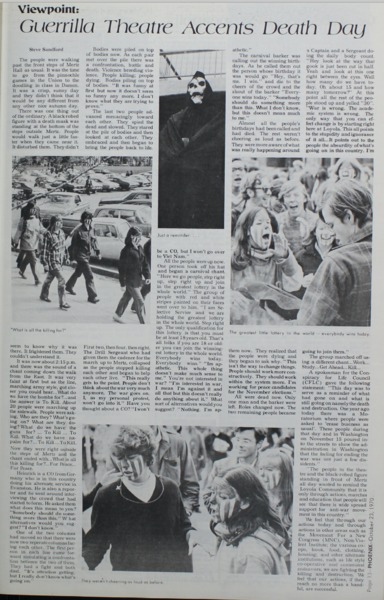
An article by Steve Sandford with four photographs discusses the "Death Day" demonstration held at the Lake Shore Campus in protest to the Vietnam War. The "guerilla theatre" techniques included marching with chilling protest songs, mock battles and death, and bitterly sarcastic performances of a draft lottery, "the winningest lottery in the whole world." The demonstrations were meant to provoke other students and call attention to the continuing war and its effects on students. Students taking part wanted peace, and they hoped to at least inspire a few people to reconsider the country's actions.
The four photos (clockwise from top) depict the cloaked skeleton figure presiding over the events, the lottery caller, two participants with striped face paint, and a group of marchers walking and chanting, "What is all the killing for?"
-

This article describes the goals of the Hunger Week tradition at Loyola and the activities for the 1980 iteration of Hunger Week.
-
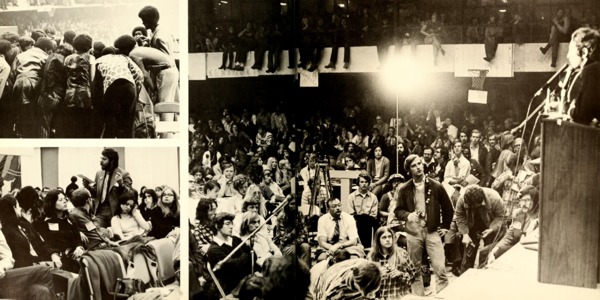
A two-page spread in the Loyolan yearbook of 1972 shows three photos from the three-day Conference for New Voters held at Loyola, run by the National Youth Causus to increase youth influence on the 1972 election. The top left photo shows a group of attendees huddled close and speaking, with one attendee standing higher than the others. The lower left photo shows a speaker walking between rows of seated attendees, gesturing with one hand. The right photo shows a speaker at a podium and a packed house, including an attendee with a camera and a balcony where attendees sit, dangling legs down over the side.
The caption reads:
"The tone was anti-Nixon, pro-peace, pro-economic stability, and pro-racial equality.
Representatives of political minorities-- the blacks, Chicanos and Latinos, and "the ladies"-- in some cases struggled to be heard."
Image 1: Entire 2-page collage.
Image 2: Detail shot of right page, p.103
-
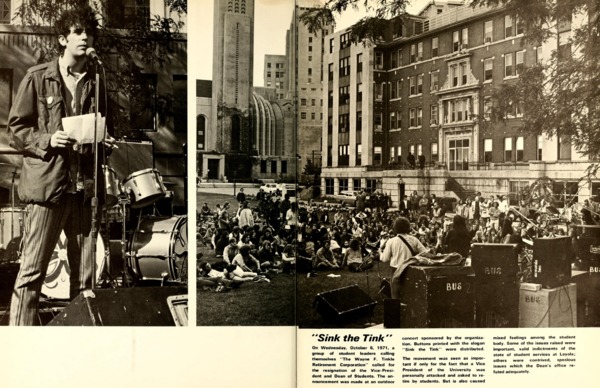
A double-page spread in the 1972 Loyolan yearbook displays two images of an outdoor concert where The Wayne F. Tinkle Retirement Corporation, a student group with the slogan "Sink the Tink," called for the resignation of Loyola vice president Mr. Tinkle. The caption reads:
"On Wednesday, October 6, 1971, a group of student leaders calling themselves "The Wayne F. Tinkle Retirement Corporation" called for the resignation of the Vice-President and Dean of Students. The announcement was made at an outdoor concert sponsored by the organization. Buttons printed with the slogan "Sink the Tink" were distributed.
The movement was seen as important if only for the fact that a Vice President of the University was personally asked to retire by students. But is also caused mixed feelings among the student body. Some of the issues raised were important, valid indictments of the state of student services at Loyola; others were contrived, specious issues which the Dean's office refuted adequately."
-
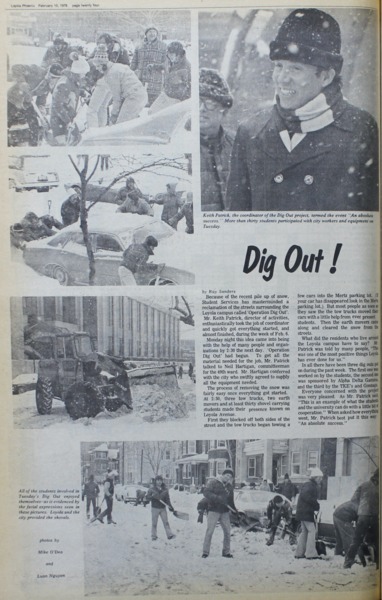
Item 1:
This article by Ray Sanders covers the Student Services effort to shovel the streets around the Loyola campus in the winter of 1977-78.
"Because of the recent pile up of snow, Student Services has masterminded a reclamation of the streets surrounding the Loyola campus called 'Operation Dig Out.'
Mr. Keith Patrick, director of activities, enthusiastically took the job of coordinator and quickly got everything started, and almost finished, during the week of Feb. 6.
Monday night this idea came into being with the help of many people and organizations by 2:30 the next day. 'Operation Dig Out' had begun. To get all the material needed for the job, Mr. Patrick talked to Neil Hartigan, committeeman for the 49th ward. Mr. Hartigan conferred with the city who swiftly agreed to supply all the equipment needed.
The process of removing the snow was fairly easy once everything got started. At 2:30, three tow trucks, two earth movers, and at least thirty shovel carrying students made their presence known on Loyola Avenue.
First they blocked off both sides of the street and the tow trucks began towing a few cars into the Mertz parking lot. (If your car has disappeared look in the Mertz parking lot.) But most people as soon as they saw the tow trucks moved their cars with a little help from the ever present students. Then the earth movers came along and cleared the snow from the streets.
What did the residents who live around the Loyola campus have to say? Mr. Patrick was told by many people, "This was one of the most positive things Loyola has ever done for us."
In all there have been three dig outs put on during the past week. The first one was worked on by the students, the second one was sponsored by Alpha Delta Gamma, and the third by the TKE's and Gonzaga.
Everyone concerned with the project was very pleased. As Mr. Patrick said, "This is an example of what the students and the university can do with a little bit of cooperation." When asked how everything went, Mr. Patrick put it this way:
'An absolute success.'"
Item 2:
Detail of the top three photos and title of the article, showing students outside with shovels, digging out cars.
Item 3:
Detail from the bottom photo in the article, showing students shoveling along a sidewalk in front of a row of houses.
-
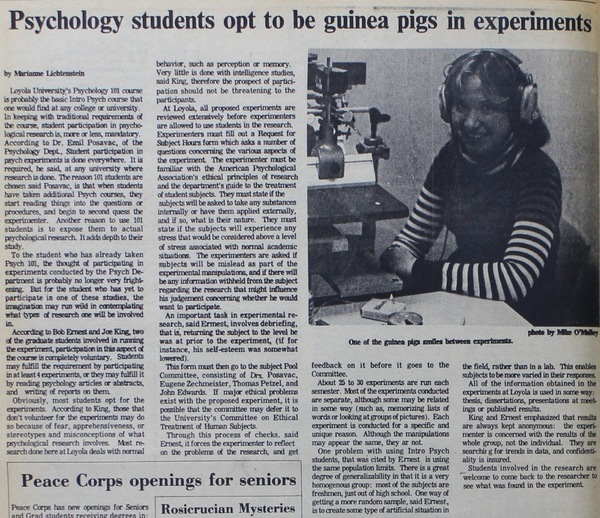
This article by Marianne Lichtenstein covers the voluntary participation of Psychology 101 students in psychological research at Loyola. Topics include how these experiments get approved, the debriefing, and the University's Committee on Ethical Treatment of Human Subjects. 25-30 experiments were run each semester, and results were kept anonymous. Students could also learn about the results afterwards. The interviewees also noted that the mostly-freshman college student pool was a limited test population, and there were probably other ways to get more diverse populations.
-
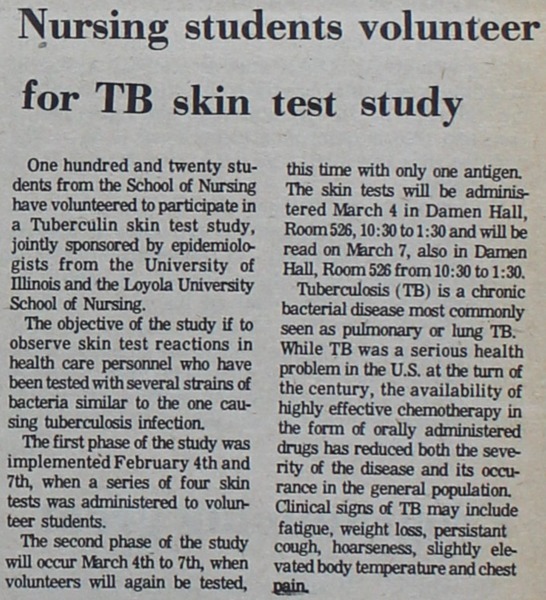
This article covers 120 nursing students' participation in a tuberculosis skin test.
"One hundred and twenty students from the School of Nursing have volunteered to participate in a Tuberculin skin test study, jointly sponsored by epidemiologists from the University of Illinois and the Loyola University School of Nursing.
The objective of the study [is] to observe skin test reactions in health care personnel who have been tested with several strains of bacteria similar to the one causing tuberculosis infection.
The first phase of the study was implemented February 4th and 7th, when a series of four skin tests was administered to volunteer students.
The second phase of the study will occur March 4th to 7th, when volunteers will again be tested, this time with only one antigen. The skin tests will be administered March 4 in Damen Hall, Room 526, 10:30 to 1:30 an will be read on March 7, also in Damen Hall, Room 526 from 10:30 to 1:30.
Tuberculosis (TB) is a chronic bacterial disease most commonl seen as pulmonary or lung TB. While TB was a serious health problem in the U.S. at the turn of the century, the availability of highly effective chemotherapy in the form of orally administered drugs has reduced both the severity of the disease and its occurance in the general population. Clinical signs of TB may include fatigue, weight loss, persistant cough, hoarseness, slightly elevated body temperature and chest pain."
-
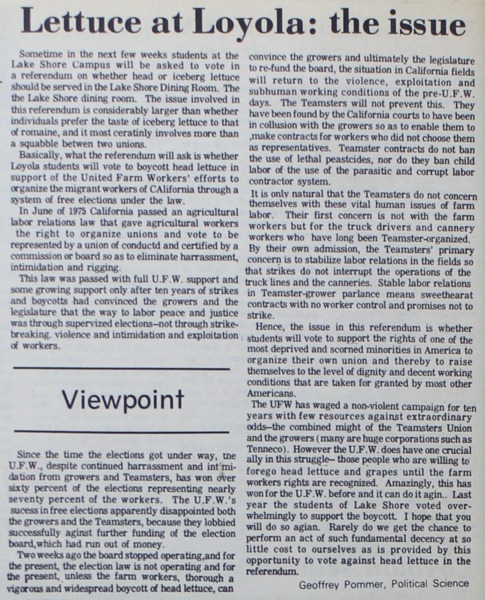
In this article, "Geoffrey Pommer, Political Science" explains the details of the upcoming Loyola referendum on whether to support the United Farm Workers by banning head lettuce. This would deprive the growers of revenue, thus supporting the UFW's nonviolent campaign for better conditions.
-

This article by Lynn Hansen describes a contest sponsored by Loyola for "original folk songs dealing with some aspect of the history of Illinois" to commemorate the bicentennial of America's independence from Britain. The contest deadline was December 31, 1975, with cash prizes for winning submissions to be announced in March, 1976. Contestants had to be Illinois residents, and students could enter, but not any Loyola employees or their families. A $2.00 handling fee was charged. Loyola would receive the rights to the three winning songs, but would make arrangements for sharing royalties.
The author describes folk songs: "Folks songs are a tradition that has been with us for many years. They are mediums of self-expression that represent cultural, social or religious heritage of a people who do not belong to any particular school, group, or sect."
-
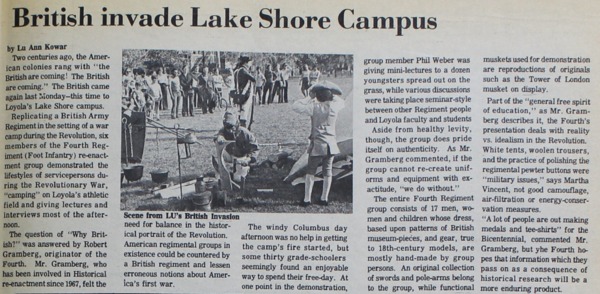
Item 1:
This article by Lu Ann Kowar covers a Revolutionary War re-enactment held at the Loyola Lake Shore Campus athletic field to commemorate the war by holding demonstrations, lectures, and interviews. Loyola students and faculty attended, as did younger students.
The reenacting group was clled the Fourth Regiment (Foot Infantry) and was made up of 17 members in handmade historic uniform with replica weapons and tools. They aimed to dispel assumptions about what the war was really like.
Item 2:
This detail includes the photo featured in the article, showing reenacters in a field using tools while a crowd watches.

























